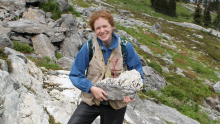Melt off from small mountain glaciers and ice caps will contribute about 12 centimetres to world sea-level increases by 2100, according to UBC research published this week in Nature Geoscience.
The largest contributors to projected global sea-level increases are glaciers in Arctic Canada, Alaska and landmass bound glaciers in the Antarctic. Glaciers in the European Alps, New Zealand, the Caucasus, Western Canada and the Western United States--though small absolute contributors to global sea-level increases--are projected to lose more than 50 per cent of their current ice volume.
The study modelled volume loss and melt off from 120,000 mountain glaciers and ice caps, and is one of the first to provide detailed projections by region. Currently, melt from smaller mountain glaciers and ice caps is responsible for a disproportionally large portion of sea level increases, even though they contain less than one per cent of all water on Earth bound in glacier ice.
“There is a lot of focus on the large ice sheets but very few global scale studies quantifying how much melt to expect from these smaller glaciers that make up about 40 percent of the entire sea-level rise that we observe right now,” says Valentina Radic, a postdoctoral researcher with the Department of Earth and Ocean Sciences and lead author of the study.
Increases in sea levels caused by the melting of the Greenland and Antarctic ice sheets, and the thermal expansion of water, are excluded from the results.
Radic and colleague Regine Hock at the University of Alaska, Fairbanks, modelled future glacier melt based on temperature and precipitation projections from 10 global climate models used by the Intergovernmental Panel on Climate Change.
“While the overall sea level increase projections in our study are on par with IPCC studies, our results are more detailed and regionally resolved,” says Radic. “This allows us to get a better picture of projected regional ice volume change and potential impacts on local water supplies, and changes in glacier size distribution.”
Global projections of sea level rises from mountain glacier and ice cap melt from the IPCC range between seven and 17 centimetres by the end of 2100. Radic’s projections are only slightly higher, in the range of seven to 18 centimetres.
Radic’s projections don’t include glacier calving--the production of icebergs. Calving of tide-water glaciers may account for 30 per cent to 40 per cent of their total mass loss.
“Incorporating calving into the models of glacier mass changes on regional and global scale is still a challenge and a major task for future work,” says Radic.
However, the new projections include detailed projection of melt off from small glaciers surrounding the Greenland and Antarctic ice sheets, which have so far been excluded from, or only estimated in, global assessments.
Nature Geoscience
www.nature.com/ngeo/
Valentina Radic
www.eos.ubc.ca/about/researcher/V.Radic.html
Musqueam First Nation land acknowledegement
We honour xwməθkwəy̓ əm (Musqueam) on whose ancestral, unceded territory UBC Vancouver is situated. UBC Science is committed to building meaningful relationships with Indigenous peoples so we can advance Reconciliation and ensure traditional ways of knowing enrich our teaching and research.
Learn more: Musqueam First Nation
Faculty of Science
Office of the Dean, Earth Sciences Building2178–2207 Main Mall
Vancouver, BC Canada
V6T 1Z4


